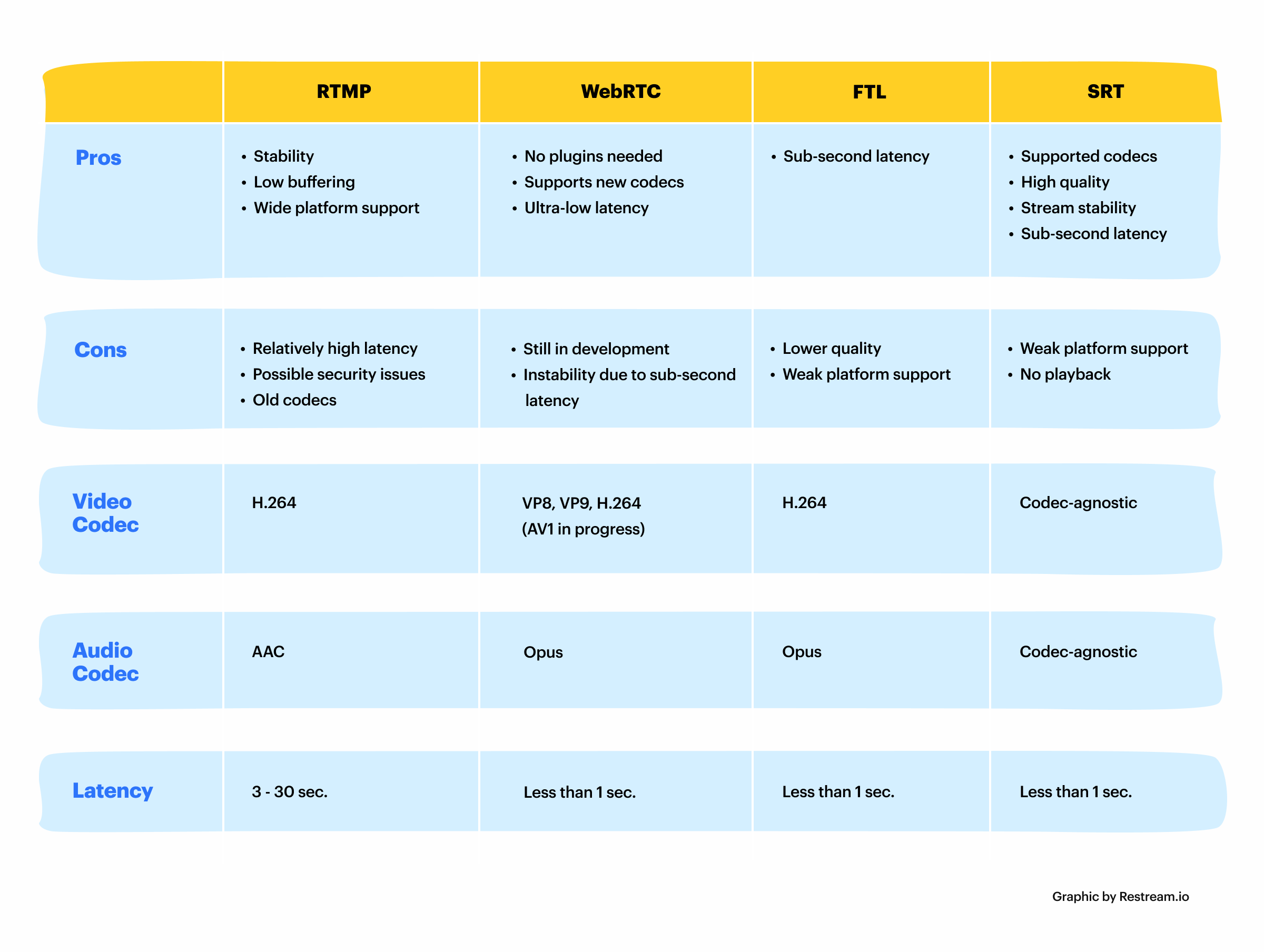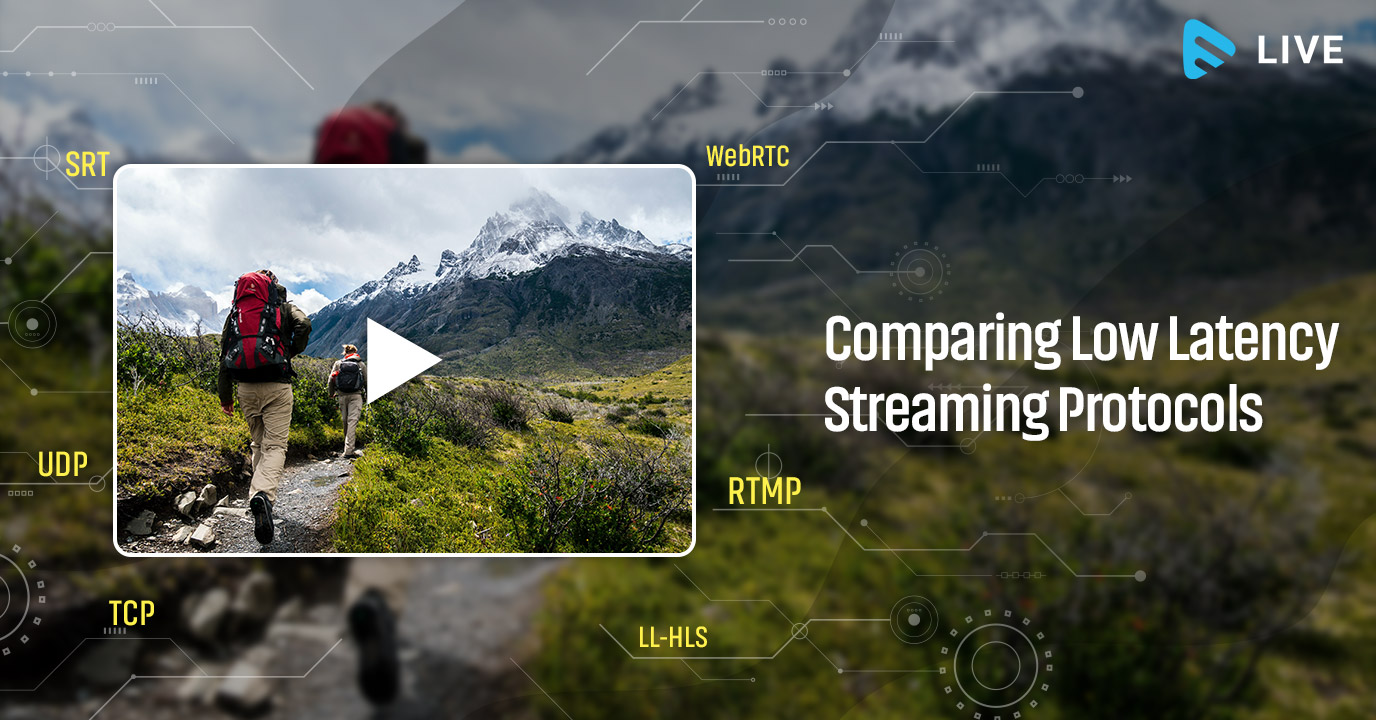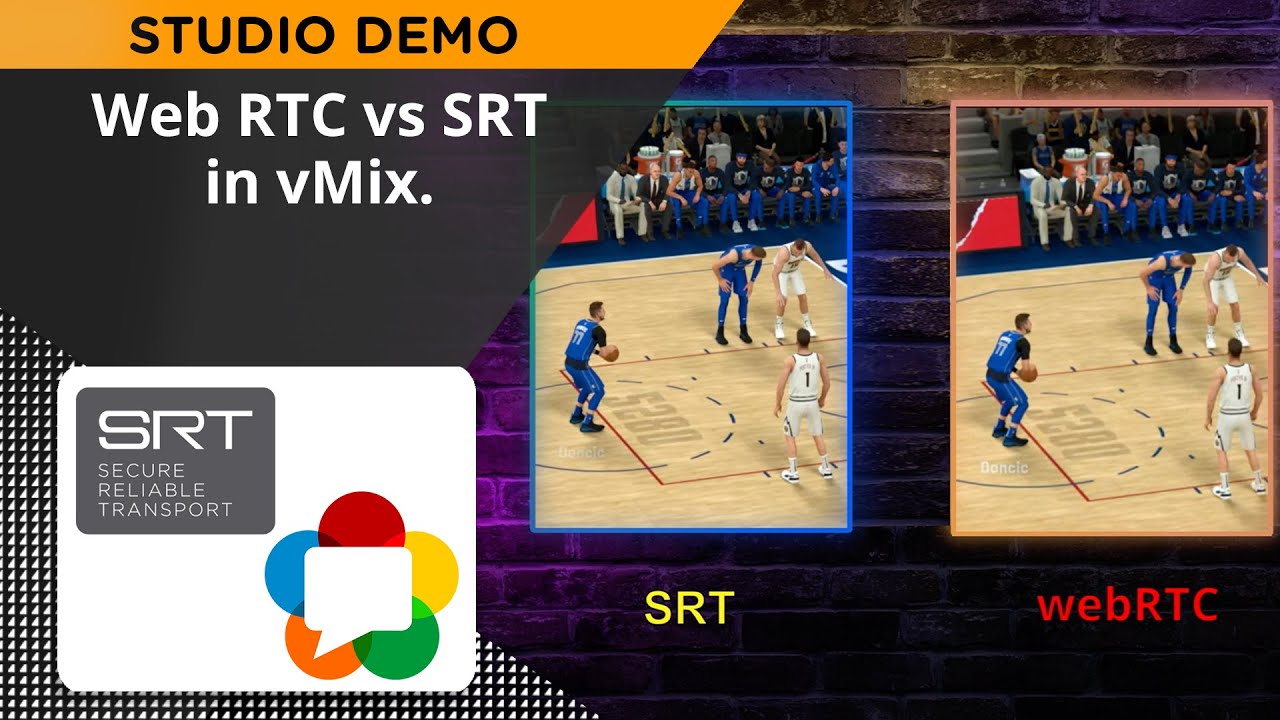SRT (Secure Reliable Transport) and WebRTC (Web Real-Time Communication) are protocols used for real-time data transmission. SRT focuses on low-latency video streaming, while WebRTC enables peer-to-peer communication in web browsers.
SRT, developed by Haivision, ensures secure and reliable video streaming over unpredictable networks. It uses UDP and provides error correction and encryption. WebRTC, an open-source project, facilitates real-time communication directly in browsers without plugins. It supports audio, video, and data sharing, making it ideal for video calls and conferencing.
Both protocols aim to enhance real-time communication, but SRT is primarily used in professional broadcasting, while WebRTC is popular for web-based applications. Choosing the right protocol depends on specific requirements and use cases.

Introduction To Streaming Protocols
Streaming protocols are essential for delivering content over the internet. They ensure seamless transmission of audio and video to users. Choosing the right protocol enhances user experience.
Importance Of Streaming Protocols
Streaming protocols play a vital role in content delivery. They handle the data transmission between servers and users. Here are some reasons why they are important:
- Quality: Ensure high-quality audio and video.
- Latency: Minimize delays in streaming.
- Reliability: Provide stable and consistent streams.
- Compatibility: Work across various devices and platforms.
Emergence Of Srt And WebRTC
Two popular streaming protocols are SRT and WebRTC. Both offer unique benefits for real-time communication.
| Protocol | Key Features | Use Cases |
|---|---|---|
| SRT (Secure Reliable Transport) |
|
|
| WebRTC (Web Real-Time Communication) |
|
|
Both SRT and WebRTC are crucial for different streaming needs. Understanding their features helps in selecting the right protocol.
What Is SRT?
Secure Reliable Transport, or SRT, is a protocol developed to optimize streaming. It ensures low-latency video delivery over unpredictable networks. SRT is primarily used for high-quality, live video streaming.
Srt Basics
SRT is designed to transport high-quality videos over the internet. It adapts to network conditions and minimizes packet loss. It offers a balance between security, reliability, and low latency.
This protocol uses UDP as the transport layer, improving speed and efficiency. SRT also includes error correction mechanisms. This ensures a smooth video playback experience.
Key Features Of Srt
- Low Latency: SRT delivers video with minimal delay.
- Security: It uses AES encryption to protect data.
- Reliability: SRT includes packet loss recovery mechanisms.
- Adaptability: It adjusts to varying network conditions.
| Feature | Description |
|---|---|
| Low Latency | Delivers video with minimal delay. |
| Security | Uses AES encryption to protect data. |
| Reliability | Includes packet loss recovery mechanisms. |
| Adaptability | Adjusts to varying network conditions. |
SRT is a robust solution for live streaming needs. It combines security, reliability, and low latency. This makes it an excellent choice for professional broadcasting.
What Is WebRTC?
WebRTC stands for Web Real-Time Communication. It is a technology that enables peer-to-peer communication directly from web browsers. This means you can share audio, video, and data without needing plugins or third-party software. WebRTC is an open-source project supported by major browsers like Chrome, Firefox, and Safari. It makes real-time communication easy and accessible.
Webrtc Basics
WebRTC is built into modern web browsers. It allows developers to create applications for real-time communication. This includes video calls, voice calls, and text chat. WebRTC uses JavaScript APIs to establish connections.
Here are some basics of WebRTC:
- Peer-to-Peer Connection: Directly connects users for fast and secure communication.
- MediaStream API: Captures and handles audio and video streams.
- RTCPeerConnection API: Manages connections and controls the flow of data.
- RTCDataChannel API: Allows for data exchange between peers.
Key Features Of Webrtc
WebRTC offers several key features that make it stand out:
- High-Quality Media: Provides high-quality audio and video for communication.
- Secure Communication: Uses encryption to keep data safe and private.
- Low Latency: Ensures minimal delay, enhancing the real-time experience.
- Cross-Platform Compatibility: Works on various devices and browsers.
- Scalability: Can handle a large number of users efficiently.
WebRTC is a powerful tool for developers. It simplifies the creation of real-time communication applications. By leveraging its features, developers can build robust and efficient communication solutions.
Performance Comparison
Comparing the performance of SRT and WebRTC is crucial. Both are popular for video streaming. They have unique strengths in latency and reliability.
Latency
Latency measures delay in data transfer. It’s critical for live streaming.
SRT offers low latency. It uses advanced error correction. This ensures smooth streaming.
WebRTC also aims for low latency. It is built for real-time communication. It works well for video calls and conferences.
Below is a table comparing their latency:
| Protocol | Latency |
|---|---|
| SRT | ~200ms |
| WebRTC | ~50ms |
Reliability
Reliability ensures consistent data delivery. It’s vital for a good user experience.
SRT excels in reliability. It uses ARQ (Automatic Repeat reQuest) to handle packet loss. This makes it suitable for unstable networks.
WebRTC focuses on real-time delivery. It uses SCTP (Stream Control Transmission Protocol) for data transmission. This ensures reliable communication.
Here’s a summary of their reliability features:
- SRT: ARQ, FEC (Forward Error Correction)
- WebRTC: SCTP, ICE (Interactive Connectivity Establishment)
Security Aspects
Security is a critical aspect when comparing SRT and WebRTC. Both protocols aim to ensure secure data transmission. This section dives into the key security elements of SRT and WebRTC.
Encryption Methods
Encryption is essential for protecting data during transmission. SRT uses AES encryption to secure its data. AES (Advanced Encryption Standard) is a widely trusted method for encrypting data.
WebRTC also uses strong encryption. It employs DTLS (Datagram Transport Layer Security) for securing data. DTLS helps protect data from interception and tampering.
| Protocol | Encryption Method |
|---|---|
| SRT | AES |
| WebRTC | DTLS |
Vulnerability Risks
Understanding the vulnerability risks of each protocol is important. SRT has a strong focus on security. It minimizes risks through efficient encryption and error recovery mechanisms.
WebRTC also aims to reduce vulnerability risks. It uses secure protocols like SRTP (Secure Real-time Transport Protocol). SRTP adds an extra layer of security.
Both protocols are designed to handle security threats effectively. Regular updates and patches keep these protocols secure.
- SRT: AES encryption, strong error recovery
- WebRTC: DTLS, SRTP for additional security

Use Cases For Srt
SRT (Secure Reliable Transport) is a protocol for video streaming. It helps in sending video smoothly. SRT is great for many uses. Here, we explore its uses in live broadcasting and remote contribution.
Live Broadcasting
SRT is perfect for live broadcasts. It makes streams stable. Broadcasters use SRT to send video to many places. It works well even with bad internet.
With SRT, there is less delay. Viewers see events almost live. Sports events, news, and concerts use SRT. It keeps the video high quality.
Remote Contribution
Remote contribution is sending video from far away places. SRT makes this easy. Reporters can send news from any place. Musicians can play together from different cities.
SRT keeps the video safe. It uses encryption to protect it. This is important for private content. SRT works with many devices. You can use it with phones, cameras, and computers.
| Use Case | Benefits |
|---|---|
| Live Broadcasting | Stable streams, less delay, high quality |
| Remote Contribution | Easy to send video, secure, works with many devices |
- Live Broadcasting: Stable streams, less delay, high quality.
- Remote Contribution: Easy to send video, secure, works with many devices.
Use Cases For Webrtc
WebRTC stands for Web Real-Time Communication. It enables real-time communication through web browsers. This technology powers many modern applications. WebRTC is versatile and supports various use cases.
Video Conferencing
Video conferencing is one of the primary use cases for WebRTC. It allows users to connect face-to-face virtually. Many popular platforms use WebRTC for video calls. The technology ensures smooth and clear communication.
Companies use WebRTC for virtual meetings. It helps teams to collaborate efficiently. Schools use it for virtual classrooms. Students and teachers connect easily through WebRTC. Healthcare providers use it for telemedicine. Doctors can consult with patients remotely.
| Use Case | Details |
|---|---|
| Corporate Meetings | Team members can collaborate from different locations. |
| Virtual Classrooms | Teachers and students can interact in real-time. |
| Telemedicine | Doctors consult with patients over video calls. |
Real-time Communication
WebRTC supports various real-time communication applications. It provides instant messaging and voice calls. Users can chat and call without delay. Online gaming platforms use WebRTC for real-time interaction. Players can communicate and strategize during gameplay.
WebRTC powers customer service chatbots. Customers get instant responses to their queries. Social media platforms use WebRTC for live streaming. Users can broadcast live events to their followers.
- Instant Messaging
- Voice Calls
- Online Gaming
- Customer Service
- Live Streaming

Choosing The Right Protocol
Deciding between SRT and WebRTC can be challenging. Each protocol has its strengths and weaknesses. This section will help you choose the right one.
Factors To Consider
- Latency: WebRTC is great for real-time communication. It has very low latency. SRT can handle higher latency but offers more stability.
- Security: Both protocols have robust security features. WebRTC uses encryption by default. SRT also supports encryption, making both secure options.
- Quality: SRT excels in maintaining video quality over unstable networks. WebRTC is optimized for real-time but can suffer in poor network conditions.
- Compatibility: WebRTC is widely supported in browsers. SRT requires more specific configurations.
- Use Case: WebRTC is ideal for video calls and conferences. SRT is better for live streaming and broadcasting.
Future Trends
Both protocols are evolving. Let’s explore their future trends:
- WebRTC:
- Increased browser support and integration.
- Enhanced performance with 5G technology.
- More tools for developers to create applications.
- SRT:
- Greater adoption in broadcasting industries.
- Improved network handling capabilities.
- More support for diverse hardware and software.
Frequently Asked Questions
What Is The Difference Between Srt And Webrtc?
SRT is designed for secure, low-latency video streaming. WebRTC is for real-time communication in browsers. Both have unique use cases and strengths.
Which Is Better For Live Streaming, Srt Or Webrtc?
SRT offers better performance for live video streaming. WebRTC is more suited for real-time communication. Choose based on your specific needs.
Can Srt Be Used In Web Browsers?
No, SRT is not natively supported by web browsers. WebRTC, on the other hand, is designed for browser-based real-time communication.
How Does Srt Handle Network Issues?
SRT uses ARQ and FEC for error correction. This ensures smooth video streaming even under poor network conditions.
Conclusion
Choosing between SRT and WebRTC depends on your specific needs. SRT offers secure, low-latency streaming. WebRTC excels in real-time communication. Both technologies have their strengths. Evaluate your requirements and select the best fit. This ensures optimal performance and user experience for your streaming or communication needs.



